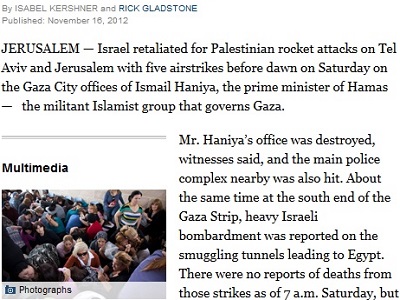
By Belen Fernandez
The New York Times’ rendering of recent violence on the border between Gaza and Israel is a shining example of the chronological sleights of hand that have come to characterize mainstream reporting on the Israeli-Palestinian conflict.
Isabel Kershner’s December 24 dispatch, “Killing and Retaliation at Gaza-Israel Border Continue Violent Cycle”, sets up the timeline as follows:
“An Israeli laborer who was repairing the security fence along the border with Gaza was fatally shot on Tuesday by a Palestinian sniper, according to the Israeli military, and Israel immediately responded with airstrikes and tank and infantry fire against targets it associated with militant groups in the Palestinian coastal territory.”
The seeming cause-and-effect relationship is emphasized by two photographs appearing side by side at the top of the article. On the left: the body of the sniper victim. On the right: the body of the three-year-old Palestinian girl cast as unintended collateral damage in the photograph’s caption: “A shell killed her as Israel, responding to the sniper attack, struck targets it associated with militant groups.”
Buried in a paragraph in the second half of the article, however, is the following detail: “On Friday, Israeli forces fatally shot a Palestinian man who approached the border fence separating Gaza from Israel.”
As it turns out, the Friday in question occurred four days prior to the Tuesday sniper fire and military assault.
The Israeli daily Haaretz adds further specifics to the manipulated chronology:
“Last Friday, 27-year-old Palestinian Oudeh Hamad of Beit Hanoun in the northern Gaza Strip was killed by Israeli soldiers’ fire. The Israeli army said Hamad was trying to sabotage the border fence, but his family said he was just collected[ing] scrap metal and plastic in the area.”
Tampering with Timelines
This is not the first instance in which the Times has deployed a truncated timeline in order to excuse Israeli attacks on Gaza.
When over 100 civilians were slaughtered in November 2012, the paper supplied the following explanation for the start of the conflict:
“Israel retaliated for Palestinian rocket attacks on Tel Aviv and Jerusalem with five airstrikes before dawn on Saturday on the Gaza City offices of Ismail Haniya, the prime minister of Hamas – the militant Islamist group that governs Gaza.”
This particular Saturday was November 10. The disingenuousness of the “retaliation” alibi was exposed by Max Ajl in an essay for Jacobin magazine:
“We know that the [Israeli] occupying forces encircling the Gaza Strip murdered a mentally unfit man approaching the border fence on November 4. They called upon him to stop, and when he did not heed their calls, they shot him down and then prevented Palestinian medics from reaching him for hours, causing him to die from what were thought to be treatable injuries. And we know that on November 8 Israeli forces shot at Ahmed Younis Khader Abu Daqqa, who was playing soccer with his friends 1,500 metres from an Israeli military post when a gunman put a bullet through his abdomen. He died soon after. Ahmed was 13.”
As for previous bloody interruptions of the holiday season, these include Operation Cast Lead – the 2008-09 Israeli initiative that exterminated approximately 1,400 Palestinians in Gaza, most of them civilians.
Advertised in the media as retaliation for Hamas’ alleged breaking of the ceasefire then in effect, Cast Lead was in fact a retaliation against Hamas’ retaliation against Israel’s breaking of the ceasefire. A relatively unadulterated cause-and-effect timeline appears in a Guardian article dated November 5, 2008:
“A four-month ceasefire between Israel and Palestinian militants in Gaza was in jeopardy today after Israeli troops killed six Hamas gunmen in a raid into the territory.
Hamas responded by firing a wave of rockets into southern Israel, although no one was injured.”
Back to the Beginning
Harvard Law professor Alan Dershowitz – proponent of extrajudicial killings, torture, and various strategies for increasing the suffering of Palestinians – has taken issue with an alleged insistence in the media “on describing… events in Gaza as ‘a cycle of violence'”.
Writing in Haaretz during the November 2012 Israeli assault, Dershowitz appeared to have entered into a competition for least relevant analogy ever: “It would be as if the media described lawful police efforts to stop illegal drug-related murders as a ‘cycle of violence’.”
As I’ve hinted before, police don’t usually pulverize apartment buildings as a means of stopping a drug-induced homicide. Beyond the analogy’s aesthetic deficiencies, it’s ludicrous to suggest an Israeli exemption from responsibility for cyclical violence that began with the very founding of the state of Israel on policies of ethnic cleansing and mass murder.
Thanks in part to media apologists for Israel who harbor a blatant disdain for chronological accuracy, Palestinian resistance to the Zionist project has been criminalized while Israel’s offensive provocations are permitted to pass as self-defense.
Without rewinding the timeline to 1948 and setting the record straight, the Israeli space-time monopoly can’t be broken.
– Belen Fernandez is the author of The Imperial Messenger: Thomas Friedman at Work, published by Verso. She is a contributing editor at Jacobin Magazine. (This article was originally published in Al Jazeera.)





